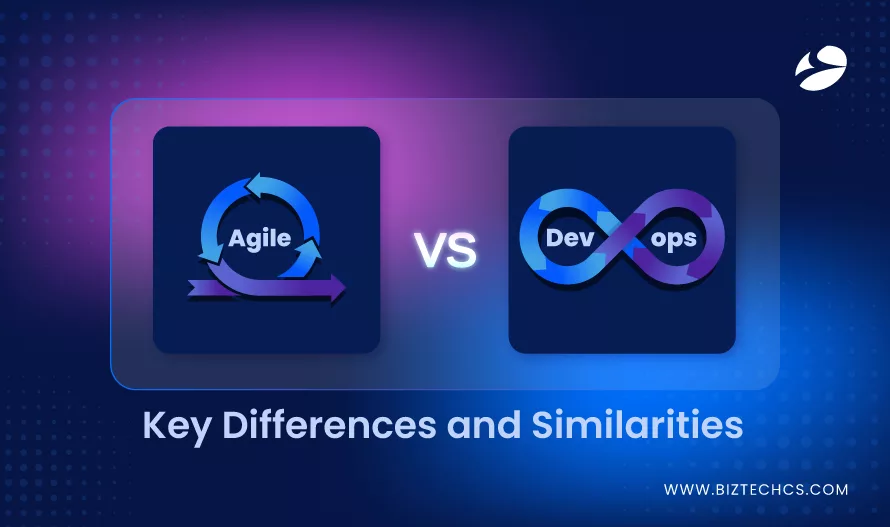
https://www.biztechcs.com/blog/navigating-the-agile-devops-connection-key-differences-similarities-and-more/
Summary
Back in time, when companies were struggling with lengthy development cycles, limited adaptability, and rigid processes in conventional development approaches like Waterfall, Agile emerged as a customer-centric practice that can lead to faster delivery and improved collaborations.
While Agile focused on improving the developer and development cycles, there still was a missing piece that could bridge the gap between software development and IT operations. DevOps appeared as that missing piece, streamlining workflows, automating processes, and accelerating delivery cycles.
This Agile-DevOps connection is something enterprises want and need to deliver high-quality software solutions fast, meeting evolving customer expectations.
In this blog post, we will explore these two practices, the key differences, how they can transform software development and delivery for you, and how DevOps services can help you in this pursuit.
Understanding The Agile-DevOps Connection
As part of modern software development, understanding the Agile-DevOps connection is important if businesses want to attain a greater level of efficiency, innovation, and collaboration. While both focus on common goals of attaining faster delivery cycles, improved collaboration, and quality development, each focuses on different aspects of software development.
To further understand this connection, let’s explore the key Agile DevOps similarities and differences!
Agile DevOps Similarities
- Improved Collaboration: Agile and DevOps methodology focuses on improving collaboration and communication between various stakeholders, developers, designers, testers, and operational teams.
- Iterative Approach: Both methodologies prefer breaking down the project into smaller increments or iterations, enabling continuous development and improvement based on feedback.
- Continuous Improvement: Agile and DevOps promote a continuous development culture where developers continually seek feedback to improve their workflows, identify areas of improvement, and make iterative changes for improved results.
- Customer-Centric: Both DevOps and Agile methodologies value customers and focus on their evolving needs, expectations, and feedback.
Agile DevOps Dissimilarities
- Scope: Agile focuses on the development phase of the software development lifecycle, impacting the planning, development, testing, and delivery processes. Whereas, DevOps is responsible for optimizing the complete software delivery lifecycle that includes development, deployment, operations, and monitoring stages.
- Roles and Responsibilities: Agile development involves roles such as scrum master, product owner, and developers who build the feature sets for your software. Whereas, DevOps includes roles like operations engineers, DevOps engineers, and site reliability engineers (SREs) who are responsible for the deployment, monitoring, and maintenance of software in the production environment.
- Practices and Tools: With tools like Jira, GitHub, and Trello, Agile practices encompass Scrum and Kanban to improve planning, collaboration, and delivery. Whereas, DevOps involves Continuous Integration (CI), Continuous Delivery (CD), site reliability engineering, and Infrastructure as a code (IaC) practices to adopt automation and improve deployment and operations. Docker, Kubernetes, and Jenkins are a few examples of DevOps tools.
Benefits of Integrating Agile With DevOps
By now, you must already have explored the similarities and dissimilarities between the two methodologies. However, an important thing to note is that it doesn’t replace one another or an alternative to one another.
Instead, you can adopt both methodologies in your software development and drive improved results. Here, let’s check the various benefits of DevOps and Agile for your project.
- Accelerated Delivery: Agile’s incremental and iterative development approaches help deliver projects faster. On the other hand, DevOps automation and continuous delivery in DevOps help attain faster time to market. Thus, Agile with DevOps forms a striking combination, helping you evolve dynamically in the rapidly evolving markets.
- Enhanced Quality: With a combination of Agile and DevOps, you can improve the quality of your product throughout the software development lifecycle. From continuous testing, feedback, and validation in Agile to automated testing and monitoring in DevOps, you can identify issues quickly and resolve them efficiently to build high-quality software solutions.
- Improved Collaboration: While Agile focuses on self-managing teams, DevOps focuses on shared responsibility. The DevOps-Agile integration is here to help cross-functional teams work together more effortlessly toward a shared goal.
- Elevated Flexibility: For projects with quick and frequent changes or experimenting, integrating Agile with DevOps is beneficial. It enables teams to respond quickly to market shifts, customer needs, and competitive pressures, ensuring that software solutions remain relevant and valuable over time.
- Optimized Resource Utilization: The duo works in tandem to streamline workflows, eliminate inefficiencies, and reduce waste. While agile practices help deliver prime features first, DevOps automates repetitive tasks, thereby freeing up resources.
- Cultural Transformation: The combined integration of Agile and DevOps fosters a culture of trust, continuous learning, empowerment, and accountability. It eliminates silos around development and boosts a transparent process.
Key Practices for Navigating the Agile-DevOps Connection
- Iterative Development: Embrace Scrum or Kanban to break down your project into multiple smaller iterations or increments and plan, develop, test, and improve based on feedback continually. Develop improved DevOps solutions to deliver value to customers.
- Continuous Integration and Delivery (CI/CD): The implementation of the CI/CD pipeline helps automate repetitive processes involved in the development, testing, and deployment of software. The CI CD pipeline meaning is to perform a series of steps in a software development lifecycle to build a quality software solution. It helps reduce manual errors and streamline workflows.
- Infrastructure as Code (IaC): Treat infrastructure as code by defining and managing infrastructure resources programmatically. Use tools like Terraform or AWS CloudFormation to automate the provisioning and configuration of infrastructure, enabling consistency, scalability, and repeatability across environments.
- Toolchain Integration: The integration of agile and DevOps toolchains can facilitate automation and smooth collaboration across SDLC. Utilize these tools to manage your project requirements, track progress, automate testing, deploy changes, and track performance.
What Challenges Organizations May Face While Implementing Agile-DevOps Connection?
- Resistance to Change: Adopting modern ways of development like Agile and DevOps could be challenging, especially if your team resist this change internally. However, through strong leadership skills and effective communication, you can talk about ways Agile + DevOps is going to make their lives easier.
- Silos and Departmentalization: In a traditional setting, teams work on their own and there’s lack of communication among two teams. With DevOps and Agile in picture, you can rise above the challenges of departmentalization and silos and ensure effective communication within your organization, maintaining transparency.
- Legacy Systems: Organizations with legacy systems may have outdated infrastructure and technical debt and find it difficult to adapt to DevOps and Agile practices. However, the transformation can boost productivity and software equality significantly. You can seek help from a reputed DevOps development company in this regard and optimize your processes.
- Lack of Alignment: Misalignment of goals and priorities between software development team, IT operations team, and other teams can cause problems and dlays in development.
- Skill Gaps and Training Needs: Organizations adapting to Agile and DevOps have to cope up with skill gaps as it requires your employees to be skilled in Agile and DevOps concepts. If your team is not skilled with these concepts, you may have to arrange training sessions to train employees on the same.
- Limited Resources and Budget Constraints: For organizations with budget constraints, investing in agile and DevOps may seem like an expense at first. However, if you think of long-term benefits and the return on investment it can bring for your organization, you would be convinced otherwise.
If that’s the case, you can seek suggestions from a DevOps consultant and get necessary insights about the same.
Conclusion
Is your organization still in the shackles of legacy systems? Do you use outdated infrastucture for your organization? Or, experiencing technology debt? Then, it is high time that you explore the concepts of DevOps and Agile and their connection.
With this guide, we hope you are better informed about these concepts and can utilize them for your organization’s growth. If you happen to face any difficulty understanding how you can adopt these practices and improve your software development lifecycle, you can connect with our expert team and get started.
With 17+ years of experience in software development and avid knowledge of Agile and DeevOps practices, our team is equipped to help you with DevOps expert consulting, development, and other technical needs.
1480
09 Apr, 2024
7 min read
1480
09 Apr, 2024
7 min read


7562
214

488